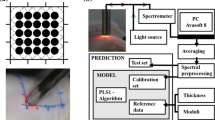Abstract
Purpose
Develop a spectroscopic method to assess cartilage thickness during the arthroscopic examination.
Methods
Currently, arthroscopy assesses cartilage damage visually; outcomes are based on the surgeon’s subjective experience. Light reflection spectroscopy is a promising method for measuring cartilage thickness based on the absorption of light by the subchondral bone. In the presented study, in vivo diffuse optical back reflection spectroscopic measurements were acquired by gently placing an optical fibre probe on different locations of the articular cartilage of 50 patients during complete knee replacement surgery. The optical fibre probe consists of two optical fibers with a diameter of 1 mm to deliver the light and detect back-reflected light from the cartilage. Centre to centre distance between the source and the detector fibers was 2.4 mm. Actual thicknesses of the articular cartilage samples were measured under microscopy using histopathological staining.
Results
Using half of the samples in the patient data, a linear regression model was formed to estimate cartilage thicknesses from the spectroscopic measurements. The regression model was then used to predict the cartilage thickness in the second half of the data. The cartilage thickness was predicted with a mean error of 8.7% if the actual thickness was less than 2.5 mm (R2 = 0.97).
Conclusion
The outer diameter of the optical fibre probe was 3 mm, which can fit into the arthroscopy channel and can be used to measure the cartilage thickness in real-time during the arthroscopic examination of the articular cartilage.





Similar content being viewed by others
Data availability
The authors declare no availability of data and materials.
References
Lyyra T, Jurvelin J, Pitkanen P, Vaatainen U, Kiviranta I (1995) Indentation instrument for the measurement of cartilage stiffness under arthroscopic control. Med Eng Phys 17(5):395–399
Adams ME, Wallace CJ (1991) Quantitative imaging of osteoarthritis. Semin Arthritis Rheum 20(6):26–39
Chan WP, Lang P, Stevens MP, Sack K, Majumdar S, Stoller DW, Basch C, Genant HK (1991) Osteoarthritis of the knee - comparison of radiography, CT, and MR imaging to assess extent and severity. Am J Roentgenol 157(4):799–806
Loeuille D, Olivier P, Mainard D, Gillet P, Netter P, Blum A (1998) Magnetic resonance imaging of normal and osteoarthritic cartilage. Arthritis and Rheumat 41(6):963–975
Rubenstein JD, Li JG, Majumdar S, Henkelman RM (1997) Image resolution and signal-to-noise ratio requirements for MR imaging of degenerative cartilage. Am J Roentgenol 169(4):1089–1096
Brittberg M, Winalski CS (2003) Evaluation of cartilage injuries and repair. J Bone Jt Surg 85A:58–69
Ayral X, Gueguen A, Ike RW, Bonvarlet JP, Frizziero L, Kalunian K, Moreland LW, Myers S, O’Rourke KS, Roos H, Altman R, Dougados M (1998) Inter-observer reliability of the arthroscopic quantification of chondropathy of the knee. Osteoar Cartil 6:160–166
Afara IO, Oloyede A (2012) Application of near infrared (NIR) spectroscopy for determining the thickness of articular cartilage. Med Eng Phys 35(1):85–95
Afara IO, Oloyede A (2021) Resolving the near-infrared spectrum of articular cartilage. Cartilage 13(1):729S-737S
Uchio Y, Ochi M, Adachi N, Kawasaki K, Iwasa J (2002) Arthroscopic assessment of human cartilage stiffness of the femoral condyles and the patella with a new tactile sensor. Med Eng Phys 24(6):431–435
Duda GN, Kleemann RU, Bluecher U, Weiler A (2004) A new device to detect early cartilage degeneration. Am J Sports Med 32(3):693–698
Spahn G, Kahl E, Klinger HM, Muckley T, Gunther M (2007) Hofmann GO Mechanical behavior of intact and low-grade degenerated cartilage. Biomedizinische Technik 52(2):216–222
Spahn G et al (2017) The frequency of cartilage lesions in non-injured knees with symptomatic meniscus tears: results from an arthroscopic and NIR-(near-infrared) spectroscopic investigation. Arch Orthop Trauma Surg 137(6):837–844
Khan B, Kafian-Attari I, Nippolainen E, Shaikh R, Semenov D, Hauta-Kasari M, Töyräs J, Afara IO (2021) Articular cartilage optical properties in the near-infrared (NIR) spectral range vary with depth and tissue integrity. Biomed Opt Express 12:6066–6080
Torniainen J et al (2022) Near infrared spectroscopic evaluation of biochemical and crimp properties of knee joint ligaments and patellar tendon. PLoS One 17(2):e0263280
Kasaragod DK, Zenghai Lu, Stephen JM (2012) Optical coherence tomography-based angle-resolved backscattering studies on bovine tendon and cartilage. Proc SPIE 8213(XVI):8213-8213G
Lim NS, Hamed Z, Yeow CH, Chan C, Huang Z (2011) Early detection of biomolecular changes in disrupted porcine cartilage using polarized Raman spectroscopy. J Biomed Opt 16(1):017003
Canpolat M et al (2017) Determination of cartilage thickness in-vivo using back reflection spectroscopy. 21st National Biomedical Engineering Meeting (BIYOMUT) i-iv. https://doi.org/10.1109/BIYOMUT.2017.8479108
Canpolat M, Denkceken T, Karagol C, Aydin AT (2011) Measuring joint cartilage thickness using reflectance spectroscopy non-invasively and in real-time. Proc SPIE 7890:789008
Öberg PÅ, Sundqvist T, Johansson A (2004) Assessment of cartilage thickness utilising reflectance spectroscopy. Med Biol Eng Comput 42:3–8
Funding
This study was supported by The Scientific and Technological Research Council of Turkey Grant (Grant No 115S474) and partly by the Akdeniz University Scientific Research Grant.
Author information
Authors and Affiliations
Contributions
Y.A.Ü.: investigation, formal analysis, data curation, writing—original draft. Ö.Ö.Ü.: methodology, investigation, data curation, writing – original draft. B.G., S.U., Ç.T., Y.S.: clinical examination, conceptualization—original draft. U.B.: data curation, writing—review and editing. İ.Ö.: investigation, data curation—original draft. M.C.: investigation, conceptualization, writing—review and editing, supervision, project administration.
Corresponding author
Ethics declarations
Ethical approval
The authors declare no ethical approval.
Consent to participate
The authors declare no consent to participate.
Consent for publication
The authors declare no consent to publish.
Competing interests
The authors declare no competing interests.
Additional information
Publisher's note
Springer Nature remains neutral with regard to jurisdictional claims in published maps and institutional affiliations.
Rights and permissions
Springer Nature or its licensor (e.g. a society or other partner) holds exclusive rights to this article under a publishing agreement with the author(s) or other rightsholder(s); author self-archiving of the accepted manuscript version of this article is solely governed by the terms of such publishing agreement and applicable law.
About this article
Cite this article
Üncü, Y.A., Ünlü, Ö.Ö., Gümüş, B. et al. Application of diffuse optical back reflection spectroscopy for determining articular cartilage thickness in a clinical setting. International Orthopaedics (SICOT) 47, 2515–2521 (2023). https://doi.org/10.1007/s00264-023-05857-z
Received:
Accepted:
Published:
Issue Date:
DOI: https://doi.org/10.1007/s00264-023-05857-z




